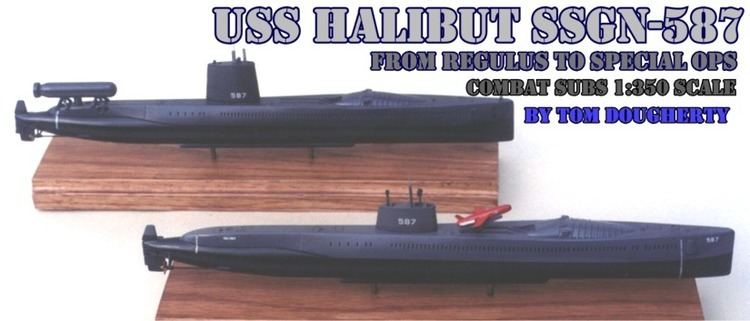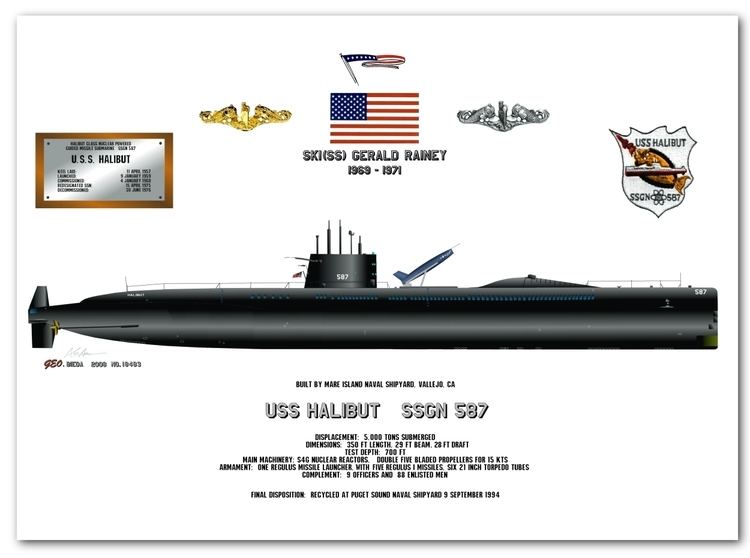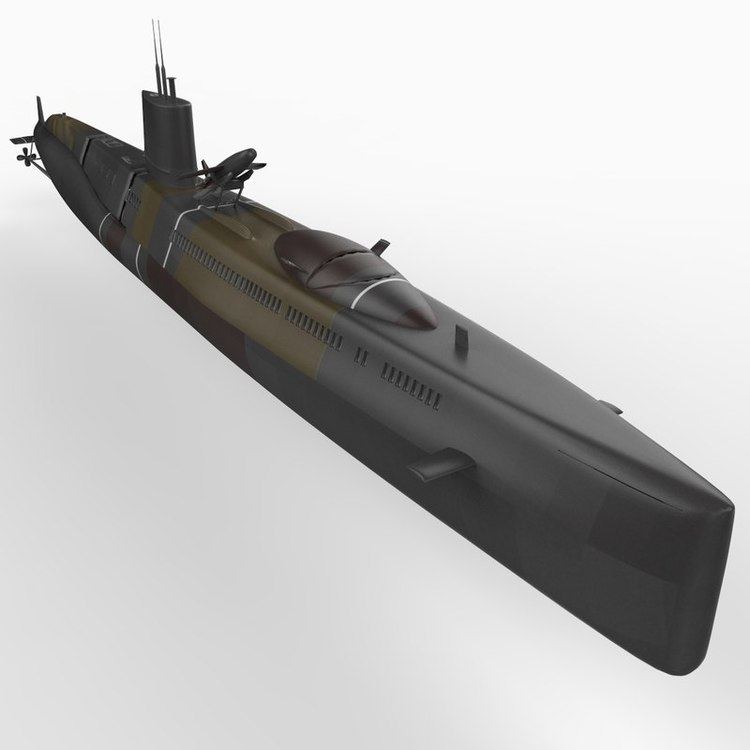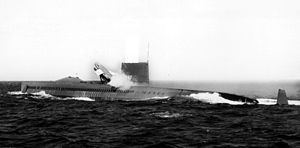Name USS Halibut Laid down 11 April 1957 Commissioned 4 January 1960 Construction started 11 April 1957 Length 107 m | Sponsored by Mrs. Chet Holifield Decommissioned 30 June 1976 Launched 9 January 1959 Beam 8.8 m | |
 | ||
USS Halibut (SSGN-587), a unique nuclear-powered guided missile submarine-turned-special operations platform, later redesignated as an attack submarine SSN-587, was the second ship of the United States Navy to be named after the halibut.
Contents
- Operational history
- Regulus deterrence patrols 1960 1965
- Special operations missions 1965 1976
- Final disposition
- Presidential Unit Citation 1968
- Presidential Unit Citation 1972
- Additional reading
- References

Operational history

Halibut's keel was laid down by Mare Island Naval Shipyard at Vallejo, California, on 11 April 1957. She was launched on 9 January 1959, sponsored by Mrs. Chet Holifield, wife of Congressman Chet Holifield of California, and commissioned on 4 January 1960 with Lieutenant Commander Walter Dedrick in command.
Regulus deterrence patrols, 1960 - 1965

Begun as a diesel-electric submarine but completed with nuclear power, Halibut was the first submarine initially designed to launch guided missiles. Intended to carry the Regulus I and Regulus II nuclear cruise missiles, her main deck was high above the waterline to provide a dry "flight deck." Her missile system was completely automated, with hydraulic machinery controlled from a central control station.

Halibut departed on her shakedown cruise 11 March 1960. On 25 March, underway to Australia, she became the first nuclear-powered submarine to successfully launch a guided missile. She returned to Mare Island Naval Shipyard on 18 June 1960, and after short training cruises sailed 7 November for Pearl Harbor to join the Pacific Fleet. During her first deployment she successfully launched her seventh consecutive Regulus I missile during a major Southeast Asia Treaty Organization weapons demonstration. Returning to Pearl Harbor on 9 April 1961, Halibut began her second deployment 1 May. During subsequent cruises, she participated in several missile firing exercises and underwent training.
Halibut deployed for the third time to the Western Pacific in late 1961, establishing a pattern of training and readiness operations followed through 1964. On 4 May 1964 Halibut departed Pearl Harbor for the last Regulus missile patrol to be made by a submarine in the Pacific. In total, between February 1961 and July 1964, Halibut undertook a total of seven deterrent patrols before being replaced in the Pacific by Polaris-equipped submarines of the George Washington class. From September through December 1964, Halibut joined eight other submarines in testing and evaluating the attack capabilities of the Permit-class submarine.
Special operations missions, 1965 - 1976
In February 1965 Halibut entered Pearl Harbor Naval Shipyard for a major overhaul, and on 15 August was redesignated as an attack submarine and given the hull classification symbol SSN-587. She sailed from Pearl Harbor on 6 September for the West Coast, arriving at Keyport, Washington, on 20 September. On 5 October she departed Keyport for Pearl Harbor and, after an eight-day stop over at Mare Island, California, arrived 21 October. Halibut then began ASW operations in the area, continuing until August 1968 when she transferred to Mare Island for overhaul and installation of: side thrusters; hangar section sea lock; anchoring winches with fore and aft mushroom anchors; saturation diving (mixed gas) habitat; long and short range side-look sonar; video and photographic equipment; mainframe computer; induction tapping and recording equipment; port and starboard, fore and aft seabed skids ("sneakers"); towed underwater search vehicle ("fish") and winch; and other specialized oceanographic equipment. She returned to Pearl Harbor in 1970 and operated with the Pacific Fleet and Submarine Development Group One (SubDevGruOne) out of Naval Submarine Support Facility San Diego (present day Naval Base Point Loma / Ballast Poinnt) with attachment offices at Mare Island until decommissioning in 1976.
Halibut was also used on secret underwater espionage missions by the United States against the Soviet Union. Her most notable accomplishments include:
The latter mission is profiled in the 1996 book, Spy Sub - A Top Secret Mission To The Bottom Of The Pacific, by Dr. Roger C. Dunham, although Dunham was required to change the name of Halibut to that of the non-existent USS Viperfish with a false hull number of SSN-655 in order to pass Department of Defense security restrictions for publication at the time.
Final disposition
Halibut was decommissioned on 30 June 1976. She was "mothballed" at Keyport/Bangor Trident Base, Washington in 1976, struck from the Naval Vessel Register on 30 April 1986, and disposed of through the Ship-Submarine Recycling Program at Puget Sound Naval Shipyard, Bremerton, Washington, on 9 September 1994.
In April 1997, officers and men of Halibut and the other four US Navy submarines that conducted strategic deterrent patrols in the Western Pacific between 1959 and 1964 were awarded the right to wear the Navy's SSBN Deterrent Patrol insignia
Presidential Unit Citation – 1968
Citation:Citation was given for the search and discovery of the wreck of a Soviet submarine K-129 in 3 miles of water during Project Azorian.
